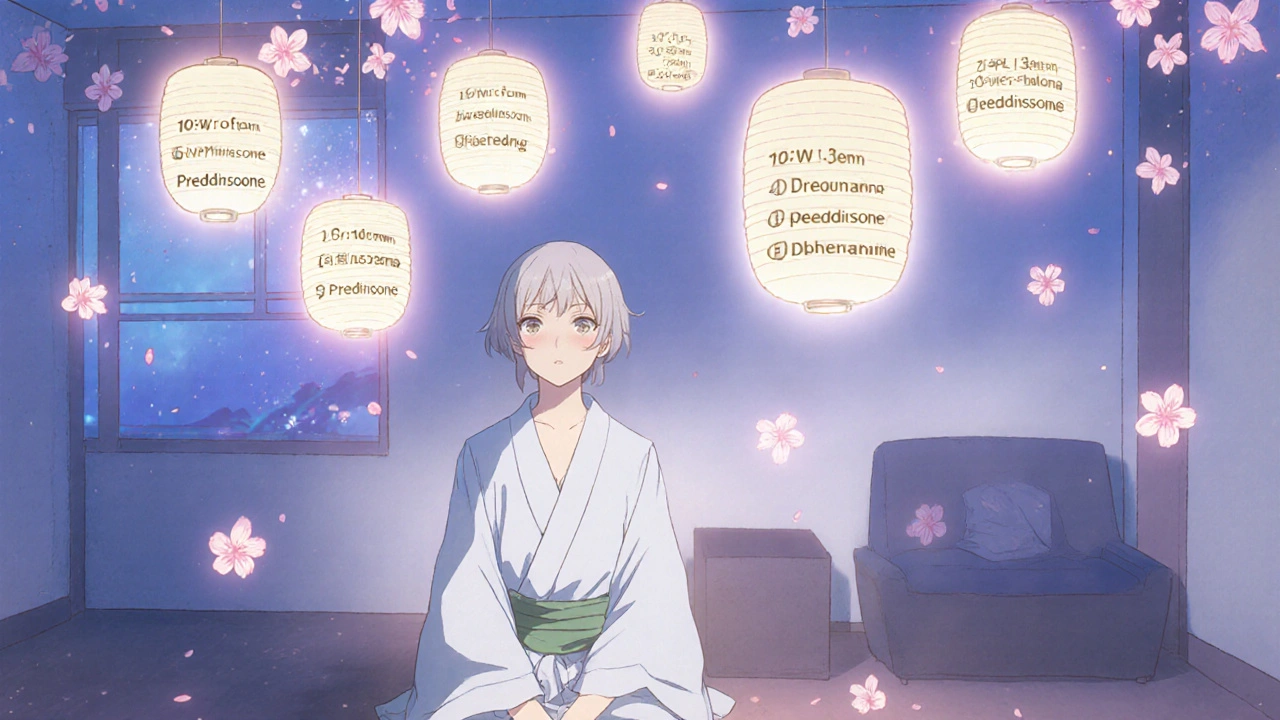Contrast Dye Reactions: Pre-Medication and Safety Planning for Safe Imaging

When you need a CT scan or X-ray with contrast dye, the last thing you want is a reaction you didn’t see coming. Even though modern contrast dyes are much safer than older versions, some people still have reactions - and for those with a history, the risk isn’t just annoying, it can be life-threatening. The good news? We know how to reduce that risk. The key is pre-medication and smart safety planning before the scan.
What Counts as a Contrast Dye Reaction?
Not every strange feeling during a scan is a reaction. Mild symptoms like a warm flush, nausea, or a metallic taste happen in up to 5% of people and usually go away on their own. These aren’t allergic reactions - they’re just side effects. True allergic-type reactions are rarer. About 1 in 500 people (0.2%) have a reaction that’s more serious: hives, itching, swelling, trouble breathing, or a drop in blood pressure. Severe reactions - like anaphylaxis - are extremely rare, happening in fewer than 1 in 2,500 scans. But when they happen, they need immediate treatment. The biggest red flag? A past reaction to the same type of contrast dye. If you’ve had a moderate or severe reaction before, your chance of having another one is around 35%. That’s why pre-medication exists - to bring that risk down to about 2%.Who Actually Needs Pre-Medication?
Not everyone with allergies needs it. A lot of people think shellfish or iodine allergies mean they’re at high risk. That’s a myth. Shellfish allergies are about proteins, not iodine. Iodine itself isn’t an allergen - it’s in your thyroid and your table salt. Even povidone-iodine (Betadine) skin prep doesn’t increase your risk for contrast reactions. Studies show people with these allergies have only a 2-3 times higher chance than the general population - not enough to justify pre-medication. The real criteria are based on your history:- Mild reaction before (like hives or nausea): Usually no pre-med needed. Switching to a different brand of contrast dye may be enough.
- Moderate reaction (like wheezing or swelling): Pre-medication is recommended, especially if the same dye was used before.
- Severe reaction (like low blood pressure or trouble breathing): Avoid contrast unless it’s an emergency. If you must have it, pre-medicate and do it in a hospital with full emergency support.
How Pre-Medication Works
The goal is simple: block your immune system’s overreaction before the dye hits your bloodstream. That’s done with two types of drugs:- Steroids (like prednisone or methylprednisolone) - calm down inflammation hours before the scan.
- Antihistamines (like diphenhydramine/Benadryl) - block the histamine that causes itching, hives, and swelling.
Oral Protocol (For Elective Scans)
If you have time - like a scheduled CT scan - you’ll likely get the 13-hour oral plan:- Prednisone 50 mg at 13 hours before the scan
- Prednisone 50 mg at 7 hours before
- Prednisone 50 mg at 1 hour before
- Diphenhydramine 50 mg at 1 hour before
IV Protocol (For Emergencies or Inpatients)
If you’re in the ER or already hospitalized, they’ll use IV meds because they work faster:- Option 1: Methylprednisolone 40 mg IV, then every 4 hours until scan + diphenhydramine 50 mg IV 1 hour before
- Option 2: Hydrocortisone 200 mg IV, then every 4 hours until scan + diphenhydramine 50 mg IV 1 hour before
What If You Don’t Have 13 Hours?
Life doesn’t always wait. If you’re in a hurry - say, a trauma patient needing a quick CT - there’s a faster option. A 2017 study in Radiology tested a 5-hour oral regimen:- Methylprednisolone 32 mg by mouth at 5 hours before
- Methylprednisolone 32 mg by mouth at 1 hour before
- Diphenhydramine 50 mg by mouth at 1 hour before
What About Kids?
Children react less often than adults. But if they’ve had a prior reaction, they still need protection. For kids 6 and older, UCSF recommends:- Cetirizine (Zyrtec) 10 mg by mouth 1 hour before the scan
Safety Planning: It’s Not Just About the Pills
Pre-medication alone isn’t enough. You need a safety net.- Location matters: If you’ve had a severe reaction before, you should be scanned at a hospital with an emergency team ready - not a standalone imaging center. Places like Mount Zion or Mission Bay Hospital in San Francisco are designated for these cases.
- Staff must be prepared: The radiology team needs to have crash carts, epinephrine, oxygen, and IV fluids on hand. This isn’t optional - it’s required by hospital accreditation standards.
- Documentation is critical: Your doctor must consult with a radiologist before scheduling. The reason for pre-medication, your reaction history, and the exact regimen used must be written down. No one should guess what you’ve had before.
- Switch the dye: If you had a reaction to one brand of contrast, switch to another brand in the same class. It’s often just as effective as pre-medication - and avoids giving you extra drugs.
What You Can’t Rely On
There are big myths floating around:- “I’m allergic to iodine” → Not true. Iodine isn’t an allergen.
- “Shellfish allergy = contrast allergy” → False. No link.
- “One reaction means I can never have contrast again” → Wrong. With proper prep, many people can safely have scans.
- “Taking Benadryl the night before is enough” → No. Timing matters. You need it within 1 hour before.

How Effective Is It Really?
The numbers tell the story:- Without pre-medication: 35% chance of repeat reaction
- With proper pre-medication: About 2% chance
Cost and Accessibility
The cost of pre-medication is tiny compared to the scan. Prednisone pills cost about 25 cents each. Benadryl is 15 cents a dose. Together, less than $1. The CT scan? $500-$1,500. So there’s no financial reason to skip it if you need it. Most academic hospitals follow the ACR guidelines exactly. Community hospitals? About 78% do. If you’re going to a smaller clinic, ask: “Do you follow the American College of Radiology’s contrast protocol?” If they don’t know, that’s a red flag.What’s Next?
The ACR is expected to release its 11th edition of the Contrast Media Manual in late 2024. Early drafts suggest a shift: less blanket pre-medication, more emphasis on switching contrast agents when possible. The future is personalized. If you had a mild reaction, maybe you just need a different dye - not steroids and antihistamines. For now, stick to the proven plan. If you’ve had a reaction before, talk to your doctor early. Don’t wait until the day of the scan. Make sure your history is in your records. Ask if you can switch the dye. Confirm you’ll be scheduled at a facility with emergency support. And if you’re getting Benadryl - bring a ride home.Frequently Asked Questions
Can I have a CT scan with contrast if I’m allergic to shellfish?
Yes. Shellfish allergies are not linked to iodinated contrast reactions. The allergy is to proteins in shellfish, not iodine. Having a shellfish allergy doesn’t increase your risk of a contrast reaction enough to require pre-medication. You can safely have contrast dye without extra drugs unless you’ve had a prior reaction to contrast itself.
Why do I need a driver if I’m getting Benadryl?
Benadryl (diphenhydramine) causes drowsiness, dizziness, and slowed reaction times. Even if you feel fine, it’s unsafe to drive after taking it. Many imaging centers require proof of a ride home before scheduling your scan. If you don’t have one, they’ll reschedule you to avoid the risk of an accident.
How long before my scan should I take my pre-medication?
For oral steroids, you need to start 13 hours before - with doses at 13, 7, and 1 hour before. If you’re short on time, a 5-hour oral regimen (methylprednisolone at 5 and 1 hour before) is an option for urgent cases. IV steroids are given immediately before the scan and repeated every 4 hours. The key is: less than 4-5 hours of lead time doesn’t work. Don’t skip timing - it reduces effectiveness.
Can I skip pre-medication if I’ve only had a mild reaction before?
Maybe. New evidence shows that for mild reactions (like mild hives or nausea), switching to a different brand of contrast dye can be just as effective as pre-medication. Many centers now consider skipping steroids and antihistamines if you switch agents - especially with modern low-osmolar dyes. Talk to your radiologist to see if that’s an option for you.
What if I have a reaction during the scan even after pre-medication?
Even with pre-medication, about 2% of people still have reactions. That’s why imaging centers must have emergency equipment ready - oxygen, epinephrine, IV fluids, and trained staff. If you feel symptoms like chest tightness, swelling, or trouble breathing during the scan, tell the technologist immediately. They’re trained to stop the scan and treat you right away.
